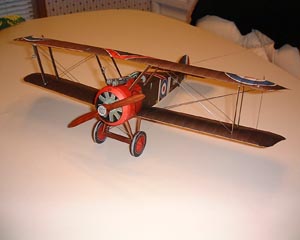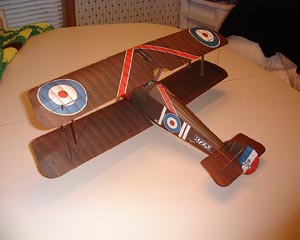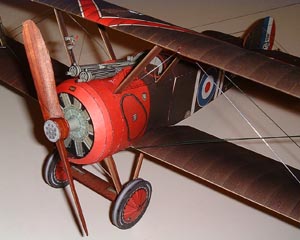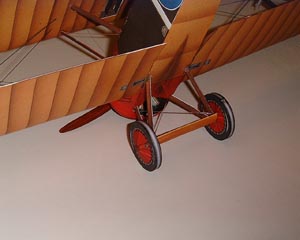

J.S. SCHREIBER – SOPWITH CAMEL F-1
1:20
I like airplanes, but have not always been successful in assembling a card model of one. The Schreiber Camel was a real delight to build and the parts fit quite well. The real beauty of a model this size, is that larger pieces are easier to cut-out, fold and glue in place. This model has a wingspan measuring just over sixteen inches and when finished, it presents an impressive model of a famous World War One bird.
I began by assembling the engine
and propeller; followed by the cockpit.
All the parts fit just as they were intended. The only problem I
experienced was little trouble in getting each prop blade to fit the hub
exactly, next followed the fuselage.
Before I completely assembled the fuselage, I deviated from the path by
starting on the undercarriage. This was
a real nice piece of work. Wheels
always are a problem for me and even I was surprised at how well the wheels
turned out. A few more parts added to
the fuselage and again I stopped and started to assemble the rudder and
horizontal stabilizer. This was it gives
me a break from working on the same part all the time and when I go to tackle
it again, it seems as if it is fresh and new.
I would be lieing if I did not admit that I encountered a few minor fit
problems with the front. The cowl fit
well, but the side fuselage pieces presented a fit problem that I just learned
to live with. A little red marker and one can hardly notice where the fitting
missed the mark.
Now the fuselage, rudder, engine,
prop, vertical stabilizer and undercarriage were done. The engine by the way
has to go inside the cowling before the last two cowl ring pieces are attached.
This left the lower and upper wing plus the wing braces to assemble. Both of the lower wings went very smoothly
and fit the fuselage as they are intended.
In the picture instructions, they give you the correct amount of dihedral
that will be needed, no problem there.
The upper wing also went together very well, and I only encountered a
problem with the leading edge; in failing to curve the small cut-out enough to
fit as it was intended. Before
attempting to attach the upper wing, I finished the wing and fuselage braces
and glued the upper wing in place. There is one weak spot on this model and
that is the tail skid. I would not
recommend that you cut-out the space that is white. I did so, and it weakened the skid to the point that it would not
hold the weight of the model. I
somewhat solved this by coating the skid in white glue and when dried the glue
gave the skid some added strength. It
still is not enough however.
In retro-respect, I should have
pierced all the rigging holes and run thread from the inside before I
completely assembled the fuselage and wings.
I did not; as I opted to use my usual method of stretched plastic spur
and/or fine wire. I feel that a much
nicer model could have been produced if I had used the thread. Even not having done this, the model still
looks great. This has to speak well of
the designer, for if I can assemble an airplane and still have it look good, I can only Imagine what some of
our fellow modelers could do with the same model. I would highly recommend this model for a beginner or an
advanced modeler alike.




This page was created by:
Saul H. Jacobs M.Ed.
Avionics Specialist, United States Air Force (Retired)
Microcomputer Technology, Pima Community College (Retired)
Tucson Arizona